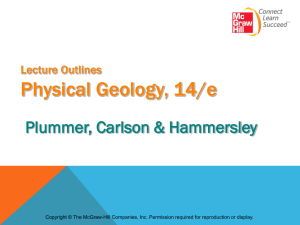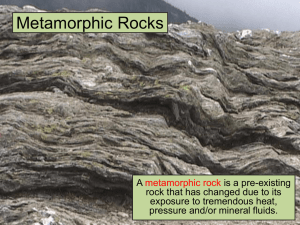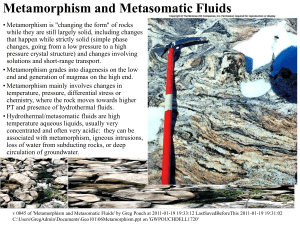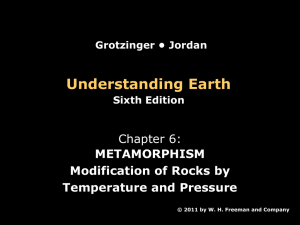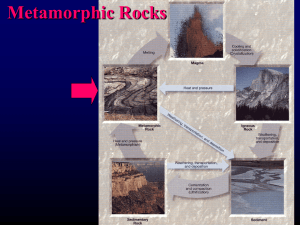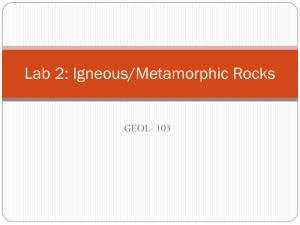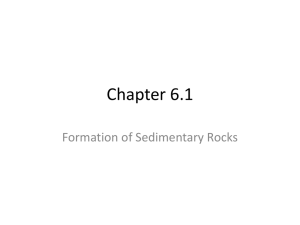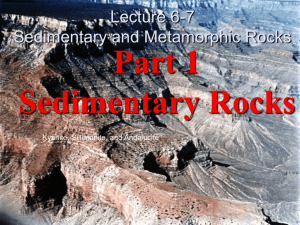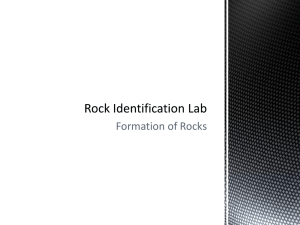Chapter 6 - Metamorphism
advertisement
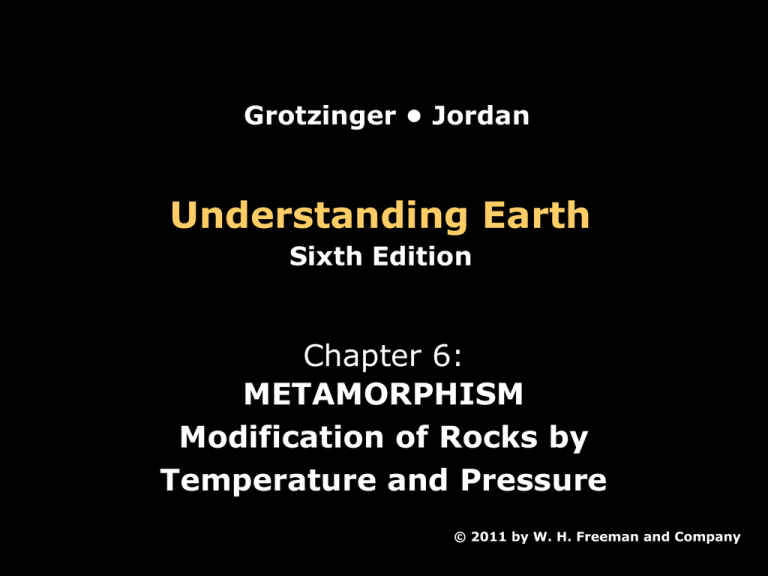
Grotzinger • Jordan Understanding Earth Sixth Edition Chapter 6: METAMORPHISM Modification of Rocks by Temperature and Pressure © 2011 by W. H. Freeman and Company Chapter 6: Metamorphism: Alteration of Rocks by Temperature and Pressure About Metamorphism • Changes in heat, pressure, and the chemical environment of rocks can alter mineral compositions and crystalline textures, making them metamorphic. • Metamorphic changes occur in the solid state, so there is no melting. Lecture Outline 1. Causes of metamorphism 2. Types of metamorphism 3. Metamorphic textures 4. Regional metamorphism and metamorphic grade 5. Plate tectonics and metamorphism 1. Causes of Metamorphism ● internal heat of Earth ● internal pressure of Earth ● fluid composition inside Earth 1. Causes of Metamorphism ● temperature increases with depth ● rate = 20º to 60ºC per km ● at 15 km depth: 450ºC 1. Causes of Metamorphism ● pressure and temperature increase with depth in all regions 1. Causes of Metamorphism 1. Causes of Metamorphism ● the role of temperature ● geothermal gradient ● shallow (20ºC / km) ● steep (50ºC / km) 1. Causes of Metamorphism ● the role of pressure (stress) ● confining pressure ● directed pressure 1. Causes of Metamorphism ● the role of pressure (stress) ● rate of increase = 0.3 to 0.4 kbar / km ● minerals are geobarometers Thought questions for this chapter At what depths in the Earth do metamorphic rocks form? What happens if temperatures get too high? Why are there no metamorphic rocks formed under natural conditions of very low pressure and temperature, as shown in Figure 6.1? 2. Types of Metamorphism ● the role of fluids ● metasomatism ● accelerated chemical reactions 2. Types of Metamorphism Depth, km 0 Oceanic crust 35 75 Oceanic lithosphere Shock metamorphism Depth, km 0 Oceanic crust 35 75 Oceanic lithosphere Shock metamorphism Depth, km 0 Regional metamorphism Oceanic crust 35 75 Oceanic lithosphere Shock metamorphism Depth, km 0 Regional metamorphism High-pressure metamorphism Oceanic crust 35 75 Oceanic lithosphere Shock metamorphism Depth, km 0 Regional metamorphism High-pressure metamorphism Contact metamorphism Oceanic crust 35 75 Oceanic lithosphere Shock metamorphism Regional metamorphism Depth, km 0 High-pressure metamorphism Contact metamorphism Oceanic crust 35 Oceanic lithosphere 75 Burial metamorphism Shock metamorphism Regional metamorphism Depth, km 0 High-pressure metamorphism Contact metamorphism Oceanic crust 35 Oceanic lithosphere 75 Water Seafloor metamorphism Burial metamorphism Thought questions for this chapter Draw a sketch showing how seafloor metamorphism might take place. 3. Metamorphic Textures 3. Metamorphic Textures Staurolite crystal Mica Foliated rocks contain platy minerals that are aligned along a preferred orientation. Staurolite crystal Mica 3. Metamorphic Textures Feldspar Quartz Mica Pyrite Staurolite Foliation is the result of compressive forces. Feldspar Quartz Mica Pyrite Staurolite Foliation is the result of compressive forces. Mineral crystals become elongated perpendicular to the compressive force. Feldspar Quartz Mica Pyrite Staurolite 3. Metamorphic Textures ● preferred orientation of crystals ● slaty cleavage ● foliation 3. Metamorphic Textures shale sandstone layers 5 cm The original bedding can be seen in the thin sandy layers. shale sandstone layers 5 cm The original bedding can be seen in the thin sandy layers. foliation plane shale sandstone layers original bedding 5 cm The original bedding can be seen in the thin sandy layers. Regional metamorphism causes cleavage planes to develop. foliation plane shale sandstone layers original bedding 5 cm 3. Metamorphic Textures Low grade Intermediate grade 3. Metamorphic Textures Diagenesis Slate Slaty cleavage Low grade Intermediate grade Phyllite High grade Schist (abundant micaceous minerals) Gneiss (fewer micaceous minerals) Migmatite Schistosity Banding Banding Foliated rocks are classified by the degree of cleavage, schistosity, and banding. Diagenesis Slate Slaty cleavage Low grade Intermediate grade Phyllite High grade Schist (abundant micaceous minerals) Gneiss (fewer micaceous minerals) Migmatite Schistosity Banding Banding 3. Metamorphic Textures ● classification of foliated rocks ● metamorphic grade ● crystal size ● type of foliation ● banding 3. Metamorphic Textures ● nomenclature of foliated rocks ● slate ● phyllite ● schist ● gneiss ● migmatite Foliated texture: schist with garnet porphroblasts 3. Metamorphic Textures ● nomenclature of granoblastic (non-foliated) metamorphic rocks ● hornfels ● quartzites ● marbles ● greenstones ● amphibolites ● granulites (granofels) Granoblastic Texture Thought questions for this chapter How is slaty cleavage related to tectonic forces? What forces cause minerals to align with one another? Would you choose to rely on chemical composition or type of foliation to determine metamorphic grade? Why? 4. Regional Metamorphism and Metamorphic Grade ● grades of metamorphism ● low ● intermediate ● high 4. Regional Metamorphism and Metamorphic Grade ● mineral isograds (zones of change) ● index minerals reflect pressure and temperature conditions ● groups of 2 to 3 index minerals form an isograd 4. Regional Metamorphism Canada ME NY Isograds VT NH Key: MA CT RI Low grade Medium grade High grade Not metamorphosed Chlorite zone Biotite zone Garnet zone Staurolite zone Sillimanite zone Index minerals define metamorphic zones. Canada ME NY Isograds VT NH Key: MA CT RI Low grade Medium grade High grade Not metamorphosed Chlorite zone Biotite zone Garnet zone Staurolite zone Sillimanite zone Index minerals define metamorphic zones. Isograds can be used to plot the level or degree of metamorphism. Canada ME NY Isograds VT NH Key: MA CT RI Low grade Medium grade High grade Not metamorphosed Chlorite zone Biotite zone Garnet zone Staurolite zone Sillimanite zone Low Grade Intermediate Grade Phyllite High Grade Schist Blueschist Gneiss Migmatite Temperature (°C) Depth (km) Pressure (kilobars) Slate 0 0 Hornfels 0 20 25 13.5 15 15 Depth (km) 10 Granulite 10 20 Amphibolite 5 Greenschist Pressure (kilobars) 5 30 200 400 Eclogite 35 600 40 1000 800 Temperature (°C) Metamorphic facies correspond to particular combinations of pressure and temperature... … and can be used to indicate specific tectonic environments. Thought questions for this chapter You have mapped an area of metamorphic rocks, such as the region in Figure 6.9a, and have observed a series of metamorphic zones, marked by north-south isograds, running from sillimanite in the east to chlorite in the west. Were metamorphic temperatures higher in the east or west? Which kind of pluton would produce the highest grade of metamorphism, a granite intrusion 20 km deep or a gabbro intrusion at a depth of 5 km? 5. Plate Tectonics and Metamorphism ● metamorphism occurs in or near ● plate interiors ● divergent plate margins ● convergent plate margins ● transform plate margins Tectonic transport moves rocks through different pressure-temperature zones, … Low P, Low T High P, High T Tectonic transport moves rocks through different pressure-temperature zones, … Low P, Low T High P, High T …and then transports them back to the shallow crust or the surface. 5. Plate Tectonics and Metamorphism ● metamorphic pressure-temperature paths ● history of burial and exhumation ● prograde and retrograde paths 5. Plate Tectonics and Metamorphism The garnet crystal initially grows in a schist but ends up growing in a gneiss. Intermediate Grade Depth (km) Pressure (kilobars) Low Grade High Grade Temperature (°C) High Grade Peak metamorphism Temperature (°C) Low temperature– high pressure metamorphism within a subduction zone Continental crust Deep-ocean sediment Shelf sediment Oceanic crust Trench Mélange ophiolites Continental crust Prograde path Peak metamorphism Retrograde path Depth (km) Pressure (kilobars) Low Grade High Grade Depth (km) Pressure (kilobars) Low Grade Peak metamorphism Temperature (°C) Low temperature– high pressure metamorphism within a subduction zone Continental crust Deep-ocean sediment Shelf sediment Oceanic crust Trench Mélange ophiolites High temperature– high pressure metamorphism within a mountain belt Suture Continental crust Multiple thrusts Deformed and metamorphosed shallow- and deepocean sediments Continental crust Continental crust Prograde path Peak metamorphism Prograde path Retrograde path Peak metamorphism Retrograde path 5. Plate Tectonics and Metamorphism ● rapid erosion (exhumation) rates of mountain ranges show a relationship between ● tectonics (orogeny) ● climate ● controls the flow of metamorphic rocks to the surface Thought questions for this chapter Draw a sketch showing how seafloor metamorphism might take place. Subduction zones are generally characterized by highpressurelow temperature metamorphism. In contrast, continent-continent collision zones are marked by moderate pressurehigh temperature metamorphism. Which type of plate boundary has a higher geothermal gradient? Explain. Key terms and concepts Amphibolite Blueschist Burial metamorphism Contact metamorphism Eclogite Exhumation Foliated rock Foliation Gneiss Granoblastic rock Granulite Greenschist Greenstone High-pressure metamorphism Hornfels Key terms and concepts Marble Mélange Metamorphic facies Metasomatism Migmatite Phyllite Porphroblast Quartzite Regional metamorphism Schist Seafloor metamorphism Shock metamorphism Slate Stress Suture Key terms and concepts Ultra-high pressure metamorphism Zeolite

